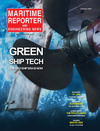
Page 21: of Maritime Reporter Magazine (February 2020)
Green Ship Technology
Read this page in Pdf, Flash or Html5 edition of February 2020 Maritime Reporter Magazine
not considered. Likewise, bio-methane, derived from organic that, given time.
sources, can be considered carbon ‘neutral’, if methane slip If bio-methane or electro-methane (see electro/synthetic is not considered. section below) fuels prove viable on a commercial scale in
For LNG and BNG, reducing the methane slip is critical the medium term, then LNG’s present carbon output could to their commercial potential as future fuels, which is why be further reduced proportionate to the fuel blend. BNG or the industry is actively trying to develop a range of related electro-methane fuels are potentially carbon neutral and there emissions control technologies. Without them, using LNG as is currently signi? cant industry investment dedicated to ex- a fuel could, in some cases, actually increase the CO2 output ploring these solutions.
from shipping, relative to heavy fuel oil or marine gas oil From a timescale perspective, at the end of the Light Gas (HFO, MGO). pathway is hydrogen, which needs at least a decade to prove
From a tank-to-wake perspective – LNG consumption viable as a commercial marine fuel; and that is probably am- within the vessel –high-pressure diesel cycle engines already bitious. There are a lot of technical obstacles in the way, the operate with negligible or no methane slip. And there are biggest being storage. Further research also is needed to con- technologies in development and in the early stages of testing ? rm the most effective way to utilize hydrogen for marine – methane slip ? lters, catalytic converters, etc., – that ulti- propulsion: fuel cells and gas turbines are potential solutions, mately could minimize carbon output across the full LNG- but they are a long way from operational viability, or cost- production chain. effectiveness.
Given its relatively limited CO2-reducing potential in its Although hydrogen is the furthest of the light-gas family present state, it would be easy – and incorrect -- to see LNG from viability, it holds signi? cant promise. It might have the as just a contributor on the pathway to meeting the 2030 lowest energy density (energy per volume) but has by far the emissions-reduction goals. Its potential may be greater than highest energy content (energy per weight); one unit would
Drew Marine ofers RSC EnviroLogic®
FOR ENVIRONMENTALLY
Grease 2 WREP – technically-advanced and 2013 VGP compliant with a broad
ACCEPTABLE LUBRICANTS, operating temperature range, excellent stability and anti-water sealing properties.
TURN TO DREW MARINE
WATER WASHOUT TEST*
COMPETITOR *Results shown after 2-minute test; 4% loss per ASTM D1264
For more information on RSC EnviroLogic®
Grease 2 WREP and our full line of EALs, contact us at [email protected] www.marinelink.com 21
MR #2 (18-33).indd 21 2/5/2020 10:51:35 AM

 20
20

 22
22
